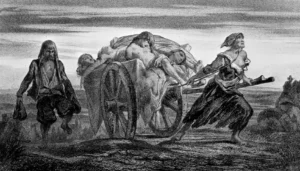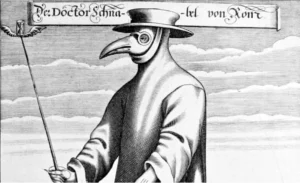The black plague: humanity’s worst epidemic
The black plague: The year 2020 will go down in history due to the worldwide development of the covid-19 pandemic, caused by the SARS-CoV-2 virus. One year after the appearance of the first cases, almost two million people have been killed around the world.
It is the deadliest pandemic since the so-called Spanish flu, caused by a variant of the influenza A H1N1 virus, which between 1918 and 1920 caused the death of between 50 and 100 million people.
However, alarming as these figures are, there was another earlier epidemic whose fatality and death toll are unprecedented in known history.
Black death
The epidemic of bubonic plague that devastated Asia, Europe and North Africa between 1346 and 1353 is known as the Black Death, Black Death, Pestilence or Plague. The mortality figures are far from being exact, but they are around a minimum of 75 and a maximum of 200 million deaths.

To put these figures in context, we must know that the human population at that time was estimated at less than 500 million people. The epidemic reduced Europe’s population by between 30% and 60%, and the world population by 25% . It was not until a century and a half later that the European population reached the level it had before the start of the epidemic.
What caused the black plague?
But what was it that caused the epidemic? At that time, medicine was almost non-existent, so the pathogen responsible for the disease was not identified until a long time later.
Specifically in 1894, when a new epidemic whose symptoms coincided with those of the fourteenth century epidemic began in Hong Kong. Alarmed at the possibility of a new catastrophe worldwide, various European governments sent teams of doctors to investigate the disease.
That same year, and separately but almost simultaneously, the Japanese doctor Kitasato Shibasaburō and the French-Swiss doctor Alexandre Yersin identified the bacterium Yersinia pestis as the cause of the infectious outbreak.
Black plague is caused by this facultative anaerobic Gram negative rod. Subsequent analysis of skeletal remains of those killed in the 14th century epidemic determined that it was the same pathogen.
The black plague in nature
The reservoir of the pathogen in nature are populations of rodents, mainly rats and marmots, with Central Asia being the region where Yersinia pestis is endemic.

The main vector of contagion of the disease in humans are fleas that feed on the blood of infected animals, specifically the oriental rat flea ( Xenopsylla cheopis ).
The bacteria survive in the digestive tract of fleas, where temperature limits their development but allows their survival. When fleas bite another mammal to feed on its blood, they regurgitate part of its stomach contents, thereby inoculating the bacteria. Once inside the body, body temperature causes the rapid multiplication of Yersinia pestis and triggers the disease.
Symptoms of the Black Death and characteristics of the disease
The disease was commonly known as the black plague because of one of its symptoms, which causes necrosis and blackening of the tissues of the human body that are at a lower temperature, usually the tips of the fingers, ears or nose.
The bacterium Yersinia pestis can give rise to three different diseases: bubonic plague, pneumonic plague, and septicemic plague.
Of the three, the bubonic plague is the most common and the least deadly. It is characterized by swollen lymph nodes giving rise to lumps, known as buboes (although it is not the only disease that causes buboes). These lumps usually appear on the neck, armpits, or groin. Other symptoms of this disease include fever and vomiting of blood. Death occurs between two and seven days after infection.
For its part, pneumonic plague occurs when the bacteria reach the lungs, either as a consequence of the bubonic plague or by inhaling the bacteria. The characteristic symptom is bloody sputum and death occurs within two to three days after infection.
Finally, septicemic plague occurs when the bacteria reach the patient’s bloodstream. It is the fastest and most lethal of the three, being able to cause death in just one day without the previous appearance of buboes. This variant of the disease acts so quickly that the diagnosis is commonly made at autopsy.
If the disease is not treated, pneumonic plague and septicemic plague have a mortality close to 100%, and bubonic plague between 30% and 60%.
Fortunately, there are antibiotics that can counteract the effect of the pathogen in any of the three variants of the disease, greatly increasing the chances of survival.
Two vaccines have also been proposed , but have not been developed. Taking into account the extreme speed with which the disease acts, in the event of a sporadic outbreak or a bioterrorist attack, the possibility of developing and applying the vaccine in time to be effective against the Black Death would be practically nil .
Preventing the spread of the disease (for example, through the use of masks) and the use of antibiotics prophylactically would be decisive to avoid an epidemic outbreak.
Historical relevance of the plague
Although the 14th century epidemic was the best known, it was neither the first nor the last caused by Yersinia pestis . The study of archaeological remains has shown that the bacteria had already infected humans at least 6,000 years ago.

The disease is described quite precisely in the first song of the Iliad, written by Homer in the 8th century BC. C., which shows that the outbreaks of the disease and its devastating effects were known at that time.
In the 6th century there was the first known epidemic of bubonic plague, known as the Plague of Justinian, so named because it spread through the Byzantine Empire during the reign of this emperor. This first epidemic caused between 25 and 50 million victims in Asia and Europe, 25% of the world’s population. The disease reappeared in different outbreaks in the Mediterranean area until 750.
Regarding the geographical origin of the Black Death epidemic that reached Europe in 1346, there is no clear evidence in which area of Asia the first outbreak occurred, but everything indicates that it was transmitted by land through the Silk Road. and later through the Genoese sailors trade routes.
It is striking that the first historical records of the disease in Europe refer to the siege of the city of Kaffa (in Crimea) by the Mongols. They launched the corpses of people killed by the bubonic plague over the city using catapults to spread the disease among the besieged. However, today it is known that corpses do not transmit plague, so the vector of contagion in the city must have been rats.
In the years after the Black Death epidemic in Europe, new outbreaks followed intermittently. Thus, there are records from the seventeenth century that indicate that in Italy almost two million people died from the bubonic plague, and in Spain in that same century more than one million. The disease gradually disappeared from Europe around the 18th century.
Finally, the third great plague epidemic began in China in 1855. It spread rapidly to India, killing more than 10 million people in both countries in a few years. It was during a later outbreak in Hong Kong in 1894 that the bacterium was first isolated and described.
Since then, sporadic outbreaks have occurred in different countries, but luckily advances in medicine have made it possible to contain the disease and greatly reduce its fatality.
Not only that, but modern sanitation practices and the use of insecticides have greatly reduced human exposure to the disease vector.
Still, the danger has not completely disappeared. In 2014 the disease began to spread in Madagascar, and in 2017 an outbreak killed 170 people on the island.
A very peculiar case occurred in 2018 in Mongolia, when the passengers of an airplane had to be quarantined after a passenger died suddenly mid-flight, due to having eaten meat from a wild marmot infected by Yersinia pestis .
This should serve as a reminder that although diseases such as the Black Death no longer cause major epidemics (fortunately) and although there are drugs that can treat the disease, they are still endemic in some regions of the world, and wildlife it can act as a transmitter of the virus.



